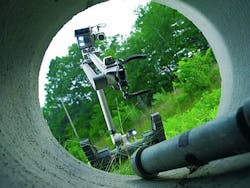DTRA eyes advanced ground robots for covert inspection of hostile chemical and nuclear sites
FORT BELVOIR, Va., 4 March 2012. Officials of the U.S. Defense Threat Reduction Agency (DTRA) at Fort Belvoir, Va., are reaching out to industry for an upcoming program tentatively called Sensitive Site Exploitation that seeks to develop advanced robotic unmanned ground vehicles (UGVs) to examine suspected chemical, biological, radiological, and nuclear sites covertly.
The DTRA Joint Science and Technology Office (JSTO) issued a request for information Friday (RFI HDTRARoboticsAPBIRFI) for the Robotics RFI and Advanced Planning Briefing to Industry - Request for Information, which contains the first sketchy details of a plan to use unmanned vehicles to inspect sites covertly that may or house research for weapons of mass destruction (WMD).
DTRA officials caution that this is not a formal request for proposals, and the agency ultimately may not pursue this project. If they do, however, DTRA officials want to develop advanced ground robots that not only can move across difficult terrain like water, ice, snow, sand, and rocks, but also conduct sensitive chemical and radiological experiments once on scene.
These will be no ordinary ground robots. They must have mobility and dexterity superior to currently fielded UGVs like the iRobot PackBot, QinetiQ TALON, and the Army's Chemical, Biological, Radiological, and Nuclear (CBRN) Unmanned Ground Reconnaissance (CUGR) robotic controller.
These robots must be able to operate by teleoperation or fully autonomously, with advanced intuitive interfaces, and have the ability to perform chemical, biological, radiological, and nuclear experiments on site and in real time, and datalink the results back to remote operators or command authorities.
DTRA's list of goals for these advanced UGVs includes the ability to:
-- use an intuitive user-machine interfaces that enable a person to operate the system without training within an hour of picking up the control equipment;
-- carry a manipulator able to unscrew and screw on the cap of a 15-milliliter falcon tube, extract a sample, and conduct a lateral flow assay with the sample from the tube, as well as operate a Joint Chemical Agent Detector (JCAD) and perform a JCAD analysis as well as a human could;
-- perform a polymerase chain reaction (PCR) assay on the current Joint Biological Agent Identification and Diagnostic System (JBAIDS) system starting with an unprocessed environmental sample from a matrix soil, water, or air collector device;
-- collect and analyze a sample of suspected radiologically active soil, water, or air using currently fielded radiological or nuclear detection systems;
-- perform a four-hour mission without external support or resupply;
-- navigate with and do 3D mapping of tunnel networks and other tight spaces without the use of the Global Positioning System (GPS);
-- carry payloads at least as heavy as 110 pounds;
-- cruise quietly at 30 to 40 miles per hour with low probability of detection;
-- move through at least 300 feet of 8-inch-deep mud, 3-feet-deep snow, icy surfaces, and terrain strewn with 3-foot-diameter boulders;
-- operate by waypoint navigation, teleoperation, or autonomous navigation with obstacle avoidance, as well as remote operation to ranges as far as 30 miles with existing communications equipment, or at unlimited ranges via satellite communications links, Internet links, or HF radio in GPS-denied environments;
-- send collected data continuously, or by burst transmission after loss of communications; and
-- function in combination (swarm) with similar robotic vehicles, or work with other kinds of UGVs.
Companies interested should send detailed descriptions of their technologies, including size, weight, and power specifications, tasks their robots can perform, control and power-management plans, and estimated time of research necessary to achieve DTRA's goals.
E-mail responses no longer than five pages to [email protected] no later than 4 April 2012. An advanced planning briefing to industry will be 28 March 2012, with details coming later.
For questions or concerns contact DTRA's Britt Kelley by e-mail at [email protected].
More information is online at https://www.fbo.gov/spg/ODA/DTRA/DTRA01/HDTRARoboticsAPBIRFI/listing.html.
